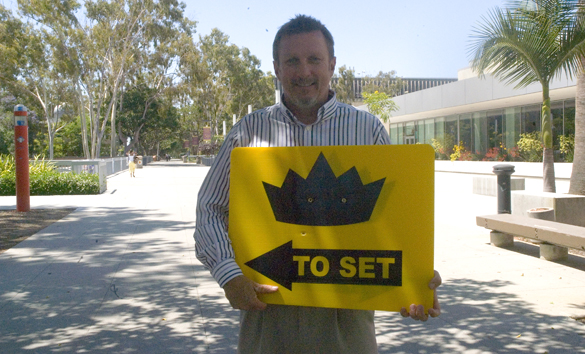Local moviegoers and scores of alumni everywhere may recognize one of the supporting cast members in Tom Hanks’ latest film, “Larry Crowne.” Standing in for the fictional East Valley Community College is none other than the California State University, Dominguez Hills campus, where shooting of scenes for the film took place a year ago.

“Larry Crowne” is one of many productions shot on the campus. Richard Chester, director of Campus Dining and Commercial Services has been working with Jean Ferguson of Ferguson’s Location Library for the last decade to market CSU Dominguez Hills as a potential location to filmmakers.
“CSU Dominguez Hills provides a broad variety of looks that are not only ‘university,’” Chester notes. “A scout might need a grass area with or without trees, a large parking lot or a theater. The Loker Student Union has a very distinct look and has been used in everything from pharmaceutical commercials to [2010] feature film, ‘The Social Network.’”
Along with these two most recent motion pictures, CSU Dominguez Hills has a number of film and television credits, including episodes of the series “24” “CSI Miami,” and “90210,” an NBC documentary on “The 70s,” and scores of commercials, including a recent one for McDonald’s.
Chester says that on-campus filming generates approximately $20,000 for an average of six to eight projects per year, which results in revenues shared by the university and its Foundation. However, he says that the daily operations of a university campus are always considered first and foremost when he and Ferguson choose productions to be allowed to film at CSU Dominguez Hills.
“The campus shouldn’t feel the pain of going through [filming],” he says. “I try to limit its impact and prevent it from disturbing the campus. We often have filming on campus and nobody knows about it, and that’s the way we want it. As much as we like to see filming, education is first.”
Chester says that an even greater benefit of filming on-campus to CSU Dominguez Hills than the extra revenue is the priceless exposure of the university to a wider public.
“Each time a filming project comes to campus it can bring 25 to 500 crew: individuals in production, marketing, and talent to our campus,” he says. “Often I have heard from crew that they didn’t realize there was a CSU Dominguez Hills and in every case are surprised how beautiful our campus is and how film-friendly we are. It is a testament to the hospitality of our students, faculty, and staff; there hasn’t been a single [production] that hasn’t commented on returning because of that.”